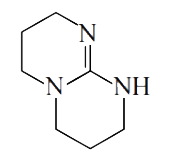The increasing order of the rate of HCN addition to compound A-D is
(A) HCHO
(B) CH3COOH3
( C) PhCOCH3
(D) PhCOPh
A<B<C<D
D<B<C<A
D<C<B<A
C<D<B<A
The correct Answer is:C
To determine the increasing order of the rate of HCN addition to the given compounds (A-D), we need to analyze the structure of each compound and the effect of substituents on the carbonyl carbon's electrophilicity.
1. Identify the Compounds:
- (A) HCHO (formaldehyde)
- (B) CH₃COOH (acetic acid)
- (C) PhCOCH₃ (acetophenone)
- (D) PhCOPh (benzophenone)
2. Understand the Mechanism:
- The reaction involves HCN acting as a nucleophile that attacks the electrophilic carbon of the carbonyl group (C=O).
- The rate of this nucleophilic addition reaction depends on the electrophilicity of the carbonyl carbon, which is influenced by the substituents attached to it.
3. Analyze the Electrophilicity:
- Formaldehyde (A): Has no electron-donating groups, making the carbonyl carbon highly electrophilic. Thus, it reacts quickly with HCN.
- Acetic Acid (B): The -COOH group is an electron-withdrawing group, but the -CH₃ group is weakly electron-donating. The overall effect is that the carbonyl carbon is less electrophilic than in formaldehyde but more than in ketones.
- Acetophenone (C): The phenyl group (Ph) is a weak electron-donating group, which decreases the electrophilicity of the carbonyl carbon compared to acetic acid.
- Benzophenone (D): Both phenyl groups are electron-donating, making the carbonyl carbon the least electrophilic among the four compounds. Therefore, it reacts the slowest with HCN.
4. Order of Reactivity:
- Based on the analysis, the increasing order of the rate of HCN addition is:
- (D) PhCOPh < (C) PhCOCH₃ < (B) CH₃COOH < (A) HCHO
5. Final Answer:
- The increasing order of the rate of HCN addition to compounds A-D is:
- (D) < (C) < (B) < (A)
- (A) HCHO (formaldehyde)
- (B) CH₃COOH (acetic acid)
- (C) PhCOCH₃ (acetophenone)
- (D) PhCOPh (benzophenone)
- The reaction involves HCN acting as a nucleophile that attacks the electrophilic carbon of the carbonyl group (C=O).
- The rate of this nucleophilic addition reaction depends on the electrophilicity of the carbonyl carbon, which is influenced by the substituents attached to it.
- Formaldehyde (A): Has no electron-donating groups, making the carbonyl carbon highly electrophilic. Thus, it reacts quickly with HCN.
- Acetic Acid (B): The -COOH group is an electron-withdrawing group, but the -CH₃ group is weakly electron-donating. The overall effect is that the carbonyl carbon is less electrophilic than in formaldehyde but more than in ketones.
- Acetophenone (C): The phenyl group (Ph) is a weak electron-donating group, which decreases the electrophilicity of the carbonyl carbon compared to acetic acid.
- Benzophenone (D): Both phenyl groups are electron-donating, making the carbonyl carbon the least electrophilic among the four compounds. Therefore, it reacts the slowest with HCN.
- Based on the analysis, the increasing order of the rate of HCN addition is:
- (D) PhCOPh < (C) PhCOCH₃ < (B) CH₃COOH < (A) HCHO
- The increasing order of the rate of HCN addition to compounds A-D is:
- (D) < (C) < (B) < (A)
Topper's Solved these Questions
- ALDEHYDES, KETONES AND CARBOXYLIC ACIDS BOOK - AAKASH INSTITUTE ENGLISHCHAPTER - ALDEHYDES, KETONES AND CARBOXYLIC ACIDS EXERCISE - Assignment (SECTION -B OBJECTIVE TYPES QUESTIONS (ONE OPTION IS CORRECT)
24 Videos
- ALDEHYDES, KETONES AND CARBOXYLIC ACIDS BOOK - AAKASH INSTITUTE ENGLISHCHAPTER - ALDEHYDES, KETONES AND CARBOXYLIC ACIDS EXERCISE - Assignment (SECTION -C Objective type questions more than one options are correct)
11 Videos
- ALDEHYDES, KETONES AND CARBOXYLIC ACIDS BOOK - AAKASH INSTITUTE ENGLISHCHAPTER - ALDEHYDES, KETONES AND CARBOXYLIC ACIDS EXERCISE - Illustrations
3 Videos
- ALCOHOLS, PHENOLS AND ETHERS BOOK - AAKASH INSTITUTE ENGLISHCHAPTER - ALCOHOLS, PHENOLS AND ETHERS EXERCISE - Try Yourself
5 Videos
- AMINES BOOK - AAKASH INSTITUTE ENGLISHCHAPTER - AMINES EXERCISE - Assignment Section -J (Aakash Challengers Questions)
9 Videos
Similar Questions
The increasing order of PKb for the following compounds will be
(1) NH2−CH=NH,

(3) CH3NHCH3
View SolutionWhich of the following increasing order of pH of 0.1 M solution of the compound
(A) HCOONH4
(B) CH3COONH4
( C ) CH3COONa
(D) NH4Cl is correct ?
View SolutionArrange the following compounds in decreasing orders of rate of hydration.
(X)CCl3CHO (Y)CH3CHO (Z)CH3COCH3 (W)CF3CHO
View SolutionObserve the following compounds
(A) CH3CH2CHO
(B) CH3COCH3
(C) Ph-CHO
(D)CH3CH(CH3)CHO
(E) HCHO
View SolutionThe decreasing order of bond dissociation energy of C-H bond in given compound is :-
(A) CH3−H (B) CH3−CH2−H
CH2=CH−CH2−H (D)
View SolutionThe increasing basicity order of the following compounds is :
(A) CH3CH2NH2
(B) CH3CH2CH2CH3∣NH
(C ) H3C−CH3∣N−CH3
(D) Ph−CH3∣N−H
View SolutionThe correct order of increasing acid strength of the compounds is
(a). CH3CO2H
(b). MeOCH2CO2H
(c) CF3CO2H
(d)
View SolutionArange the following in increasing order of reactivity towards nucleophilic addition:
HCHO,CH3CHO,CH3COCH3
View SolutionArrange the following in decreasing order of nucleophilic addition
CH3CHO,CH3COCH3,HCHO,C2H5COCH3
View SolutionArrange .the following in increasing order of stability of carbocation.
(a) (CH3)2C−CH2CH3
(b) (CH3)3C
(c) (CH3)2CH
(d) CH3CH2
View Solution
